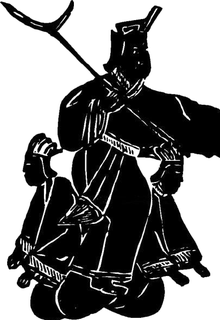Ji (polearm)


The ji (Chinese: 戟) was a Chinese polearm used in one form or another for over 3000 years, from at least as early as the Shang dynasty until the end of the Qing dynasty. They are still used for training purposes in many Chinese martial arts.
The ji was initially a hybrid between a spear and a dagger-axe. It was a relatively common infantry weapon in Ancient China, and was also used by cavalry and charioteers.

In the Song dynasty, several weapons were referred to as ji, but they were developed from spears, not from ancient ji. One variety was called the qinglong ji (Chinese: 青龍戟; literally: "cerulean dragon ji"), and had a spear tip with a crescent blade on one side. Another type was the fangtian ji (Chinese: 方天戟; literally: "square sky ji"), which had a spear tip with crescent blades on both sides.[1][2] They had multiple means of attack: the side blade or blades, the spear tip, plus often a rear counterweight that could be used to strike the opponent. The way the side blades were fixed to the shaft differs, but usually there were empty spaces between the pole and the side blade. The wielder could strike with the shaft, with the option of then pulling the weapon back to hook with a side blade; or, he could slap his opponent with the flat side of the blade to knock him off his horse.